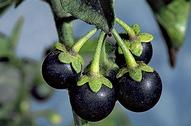|
|
Dry
Beans
> Year-Round IPM Program > Preharvest > Weed
Survey
Dry Beans
 Preharvest
Weed Survey Preharvest
Weed Survey
Groundcherry, black nightshade, and hairy nightshade berries severely
reduce bean quality during harvesting because they do not dry in
windrows. During threshing, berry juices stain the beans; the sticky
juices on the beans collect dirt and debris during harvest and
warehouse handling that cannot be cleaned off. The sticky seeds
of these weeds may also slow or clog the thresher. In storage,
moisture from berries can lower quality. Berries left in the field
will infest the soil for the following year. If present, pull and
carry these weeds out of the field before harvesting.
Survey immediately before harvest to determine the spectrum of
weeds present for next year's planning records. Records from previous
crops will indicate which weeds escaped control, thus possibly
infesting future crops.
How to survey
- Walk through each field in a random pattern.
- Rate the degree of infestation for each weed species on your
weed survey form. Use either a numeric scale from 1 to 5 (1
being the lightest, 5 being the heaviest), or rate as "light," "medium," or "heavy."
- Check fencerows, ditch banks, field edges, and wet spots
as these may be problem areas for weed growth and potential
sources for wind disseminated seed. Note the dominant species
on the monitoring form.
- Pay particular attention to perennial weeds.
- Sketch a map of the field and mark areas with major weed
infestations for follow-up control action, noting carefully
the location of weeds producing seed.
- Indicate the growth stage of the weed (seedling or mature).
- Record
results on a weed survey form .
Important links
Top of page
|


